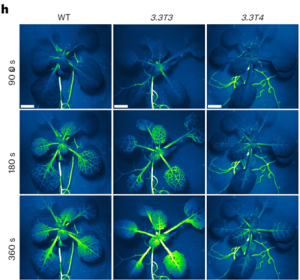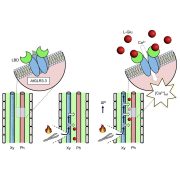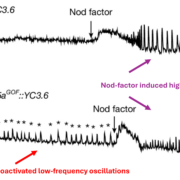Glutamate receptors shape plant systemic wound signaling and anti-herbivore defense
 Systemic immunity, where local plant interactions with microbes or insects trigger enhanced resistance in distant organs, has parallels to the nervous system in animals. In plants, GLUTAMATE RECEPTOR-LIKE (GLR) genes have a pivotal role in long-distance wound signal transmission and the initiation of defense mechanisms including the accumulation of the defense hormone jasmonate (JA) at distal sites. Like the animal counterparts, plant GLRs function as ligand-gated Ca2+-permeable channels formed by homo- or hetero-tetrameric subunits. Despite this structural similarity, the regulatory components and molecular mechanisms governing plant GLR channel activity have remained elusive. In new work, Yan and colleagues unraveled the regulatory role of the cytoplasmic carboxy-terminal domain (CTD) in GLR3.3 function. Although GLR3.3 does not have a canonical calmodulin (CaM) binding domain, experimental studies showed that it does in fact bind CaM and that this CaM-binding domain in the CTD influences the desensitization of the GLR3.3 channel. Contrary to loss-of-function mutants compromised in defense, CRISPR-engineered GLR3.3 mutants with a five-amino-acid deletion in CTD were found to be a gain-of-function allele. This mutant exhibits prolonged slow wave potential and heightened JA-response, possibly due to decreased CaM-binding. Notably, this gain-of-function allele facilitated a more robust systemic JA response and improved anti-herbivore defense, all without impairing plant growth under normal conditions. This research offers insights into the intricate regulatory mechanisms of plant GLRs, paving the way for targeted strategies to fortify plant growth and defense. (Summary by Ching Chan @ntnuchanlab) Nature Plants 10.1038/s41477-023-01578-8
Systemic immunity, where local plant interactions with microbes or insects trigger enhanced resistance in distant organs, has parallels to the nervous system in animals. In plants, GLUTAMATE RECEPTOR-LIKE (GLR) genes have a pivotal role in long-distance wound signal transmission and the initiation of defense mechanisms including the accumulation of the defense hormone jasmonate (JA) at distal sites. Like the animal counterparts, plant GLRs function as ligand-gated Ca2+-permeable channels formed by homo- or hetero-tetrameric subunits. Despite this structural similarity, the regulatory components and molecular mechanisms governing plant GLR channel activity have remained elusive. In new work, Yan and colleagues unraveled the regulatory role of the cytoplasmic carboxy-terminal domain (CTD) in GLR3.3 function. Although GLR3.3 does not have a canonical calmodulin (CaM) binding domain, experimental studies showed that it does in fact bind CaM and that this CaM-binding domain in the CTD influences the desensitization of the GLR3.3 channel. Contrary to loss-of-function mutants compromised in defense, CRISPR-engineered GLR3.3 mutants with a five-amino-acid deletion in CTD were found to be a gain-of-function allele. This mutant exhibits prolonged slow wave potential and heightened JA-response, possibly due to decreased CaM-binding. Notably, this gain-of-function allele facilitated a more robust systemic JA response and improved anti-herbivore defense, all without impairing plant growth under normal conditions. This research offers insights into the intricate regulatory mechanisms of plant GLRs, paving the way for targeted strategies to fortify plant growth and defense. (Summary by Ching Chan @ntnuchanlab) Nature Plants 10.1038/s41477-023-01578-8





